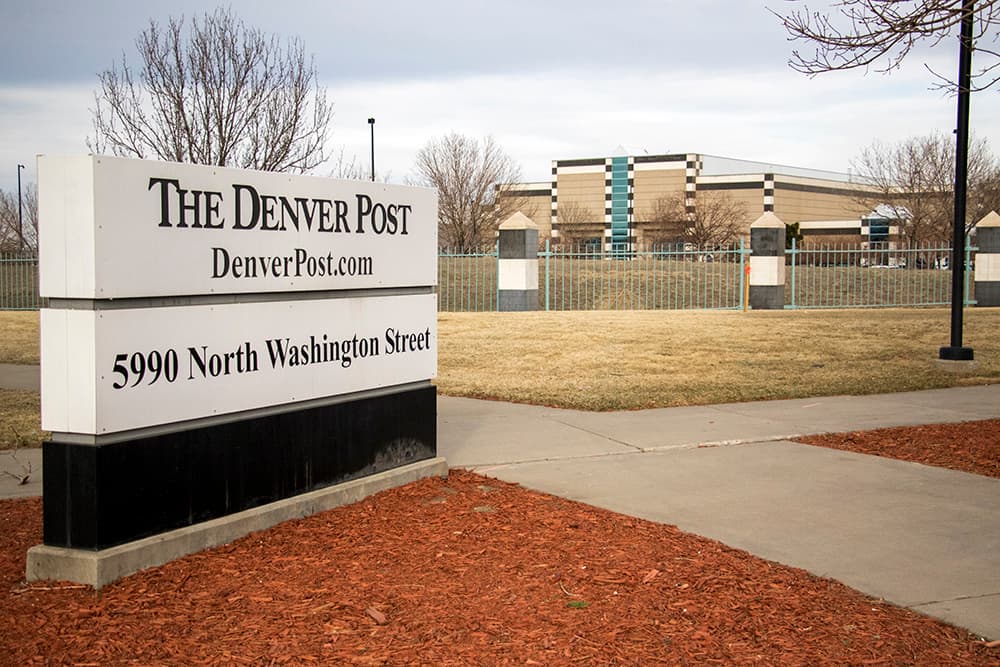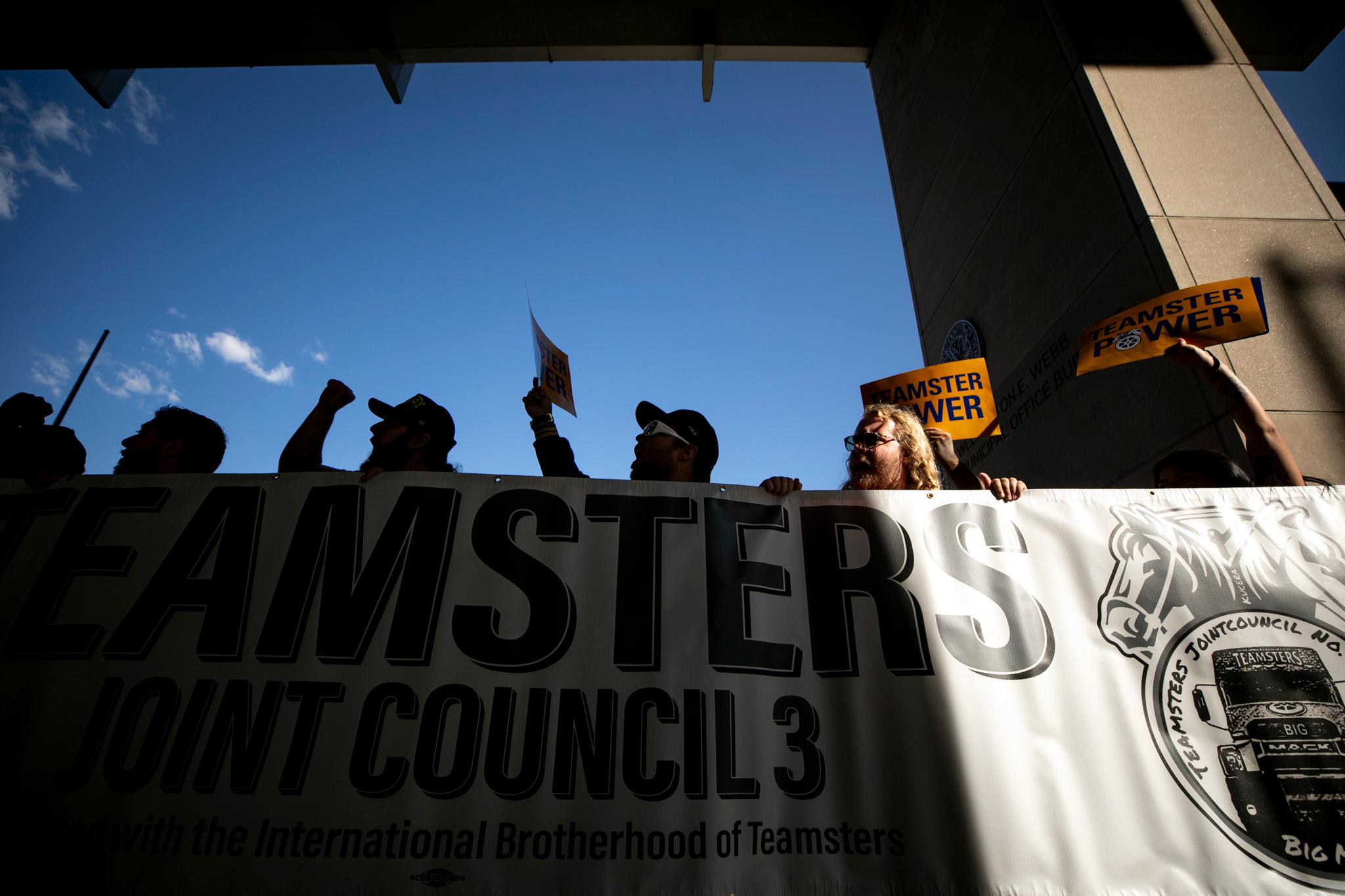
Little more than three months after the Denver Post went through a round of layoffs that cut five newsrooms jobs, and shortly after a cost-saving move to a new building and the implementation of a hard paywall to generate more revenue, its newsroom has learned it will lose another 30 staffers.
Editor Lee Ann Colacioppo delivered the news in a staff meeting Wednesday afternoon.
In a memo sent to Denver Post staff, she wrote, "I’m sure some commenters will cheer what they believe is the eventual demise of the mainstream media, but there is nothing to celebrate when a city has fewer journalists working in it."
This is a weird one for us to report. In addition to it being a story about another local news organization, three of us at Denverite were once Denver Post employees, we have friends who work there and we obviously believe in the importance of local journalism.
It's also weird because, as is now customary, the facts about the impending Denver Post cuts were reported by Denver Post reporters in the Denver Post newsroom as they were learning about them, and the early parts of the story played out on Twitter.
Jon Murray, the Post's city hall reporter, was among the first to tweet the news after Colacioppo told the staff.
"In a staff meeting, the @denverpost editor just told us that we are cutting 30 positions in the newsroom," he tweeted. "There are some sobs in the room."
In response to one of the many people asking if there will be any Denver Post left, he later added, "The newsroom will be 1/3 smaller. And as hard as we'll try, there is no way we'll be covering Denver and Colorado in the way it deserves."
Noelle Phillips, who covers law enforcement and public safety for the Post, said in a tweet that Colacioppo was caught by surprise when she learned last week that she had to make the cuts.
Kieran Nicholson, a breaking news reporter at the Post and chairman of the Newsroom Unit of the Denver Newspaper Guild, told Denverite the newsroom has been asked to cut 25 union employees and five non-union employees — the latter of which include managers and positions that are exempt for various reasons.
By April 9, those 25 people will be gone. The rest will leave by June 1.
"It’s a big hit," Nicholson said. "And it hurts."
Where the cuts will happen has yet to be determined. Staff have until 5 p.m. next Wednesday to accept a severance package and voluntarily leave, Nicholson said. That system, which was put in place during November's cuts, is meant to give a senior staffer the chance to save a young journalist's job.
"There’s a volunteer process where somebody who is willing or ready to go for whatever reason, they can volunteer," he said.
After that, the layoffs start.
"Once they start the process there’s a blueprint for it according to the [union] contract," Nicholson said. "They identify a job title, they say how many people they want [to cut] in those positions, then they start from the bottom up. It’s the last person in the door is the first person out."
The Denver Post has been taking hits for years, and its hedge fund owner's demands keep coming.

The Denver Post is owned by Digital First Media, the second-largest newspaper company by circulation in the country. Digital First is controlled by Alden Global Capital, a New York City-based hedge fund that specializes in distressed businesses.
In a story on dfmworkers.org last week, investigative reporter Julie Reynolds wrote that "Alden Global Capital siphoned hundreds of millions of dollars from one of America’s largest news chains ... damaging local news organizations to finance insider investment deals." Solus Alternative Asset Management, a hedge fund that owns a 24 percent minority share in Digital First Media, filed a suit against Alden alleging as much, she reported.
Alden invested the money it took from DFM newspapers "in a failing pharmacy chain, risky Greek sovereign debt and other questionable investments 'entirely unrelated to the company's core businesses,'" Reynolds wrote.
Digital First Media-owned papers across the country, which total more than 200, have been subject to brutal staff cuts, including Colorado's Boulder Camera, Longmont Times-Call, Loveland Reporter-Herald and the Estes Park Trail-Gazette.
In 2012, the Post lost an estimated 16 copy editors, according to Westword.
In early summer of 2015, the Post was told to cut 20 newsroom jobs through buyouts. Greg Moore, editor at the time, told Denver Business Journal then that digital ad revenue had grown and that the journalists' work was drawing a larger audience every year.
A year later, the newsroom was told to cut 26 newsroom jobs in another round buyouts. When not enough people took a buyout, three staffers were laid off. At the time, Westword cited "multiple reliable sources" who said the Post brought in more than $25 million in profits at the end of the most recent fiscal year.
November 2017's five cuts included managing editor Linda Shapley, who announced her resignation at the time, likely saving other jobs.
Colacioppo said the newspaper must shoulder part of the blame in her memo to staff after Wednesday's annoucement:
"The crisis facing regional newspapers like The Denver Post is real. It would be easy for us to turn the blame for these cuts on our owners, but the fact is we have not figured out how to generate the revenue it takes to run the news operation we’d all love to have."
Earlier this year, the Post left its building on Civic Center Park and moved the newsroom to its printing plant in Adams County in an effort to save money. It also launched a subscription model and paywall.
The Denver Post staff will be small compared to major newspapers in cities similar to Denver in size.
Michael A. Fuoco, president of the Newspaper Guild of Pittsburgh, says his union represents 147 people in the newsroom of the Pittsburgh Post-Gazette, where he's worked for 34 years. That doesn't include managers, and he guessed there might be 18 to 20 of them.
The 2016 Pittsburgh metropolitan statistical area population was estimated at about 2.3 million.
"We used to have 300 members," he said. "That goes back about 15 years. We've been essentially cut in half. That was all through attrition and buyouts. None of those were layoffs."
Leadership at the Oregonian in Portland declined to comment, but their staff page lists about 80 people working there. The 2016 Census estimate put the Portland-Vancouver-Hillsboro metro area at 2.4 million.
In Austin, estimated at 2.1 million people in the metro area, the American-Statesman's staff page lists nearly 100 people.
In the St. Louis area, population estimated at 2.8 million, the Post-Dispatch's staff page lists about 90 people. A newsroom staffer confirmed that the page was up-to-date.
For each of those newsrooms, too, the numbers today represent depleted ranks.
The 2016 population estimate for Denver was about 2.9 million. Nicholson says the newsroom is currently at just under 100 staffers, and will end up at just under 70.
At its peak, the Denver Post newsroom employed about 300 journalists.
Denverites have wondered what power they have to help the Post.

"We really are cut very thin already, so any position eliminated hurts," Nicholson said. "You don’t do more with less. You do less with less. Unfortunately, it will affect our coverage and our coverage will suffer."
During Wednesday's staff meeting, there was a discussion about re-prioritizing in the aftermath — weighing what's best for readers and how to best serve the community, Nicholson said.
When the Post announced its paywall earlier this year, some on social media expressed hope that their subscriptions could save the Post while others expressed concern that it wouldn't. And while the paywall launch was followed closely buy this round of cuts, Nicholson said the first thing people can do to help is still to subscribe.
"The other thing is just, through social media, either watch the Post or the news guild and retweet stories about what’s going on," he said. "A lot of people aren’t aware of what’s going on with this business, the Denver Post and the industry, journalism, in large terms."
There's also still hope that the Post might be bought from Alden by a local interest.
"We don’t have a local owner," Nicholson said. "We feel if we had a local owner — someone who is invested in the community, someone who cares about the community, someone who lives here — we'd be better off."
For now, staffers keep working.
"I thought today would be a hard day. It's an absolutely horrible one," Murray tweeted about an hour after breaking the news. "Now back to work. Does anyone have an opinion to share about the @MayorHancock text message scandal and the City Council's statement about their approach to it?"
Dave Burdick contributed to this report.











